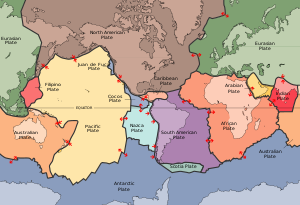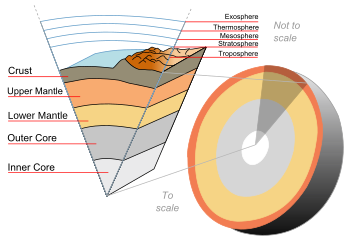Lithosphere


The lithosphere (IPA: [ˈlɪθ.ə.sfiɹ], from the Greek for "rocky" sphere) is the solid outermost shell of a rocky planet. On the Earth, the lithosphere includes the crust and the uppermost mantle which is joined to the crust across the Mohorovičić discontinuity. Lithosphere is underlain by asthenosphere, the weaker, hotter, and deeper part of the upper mantle. The base of the lithosphere-asthenosphere boundary corresponds approximately to the depth of the melting temperature in the mantle. As the conductively cooling surface layer of the Earth's convection system, the lithosphere thickens over time. It is fragmented into tectonic plates (shown in the picture), which move independently relative to one another. This movement of lithospheric plates is described as plate tectonics.
The concept of the lithosphere as Earth’s strong outer layer was developed by Barrell, who wrote a series of papers introducing the concept (Barrell 1914a-c). The concept was based on the presence of significant gravity anomalies over continental crust, from which he inferred that there must exist a strong upper layer (which he called the lithosphere) above a weaker layer which could flow (which he called the asthenosphere). These ideas were enlarged by Daly (1940), and have been broadly accepted by geologists and geophysicists. Although these ideas about lithosphere and asthenosphere were developed long before plate tectonic theory was articulated in the 1960's, the concepts that strong lithosphere exists and that this rests on weak asthenosphere are essential to that theory.
The division of Earth's outer layers into lithosphere and asthenosphere should not be confused with the chemical subdivision of the outer Earth into mantle, and crust. All crust is in the lithosphere, but lithosphere generally contains more mantle than crust.
There are two types of lithosphere:
- Oceanic lithosphere, which is associated with Oceanic crust
- Continental lithosphere, which is associated with Continental crust
Oceanic lithosphere is typically about 50-100 km thick (but beneath the mid-ocean ridges is no thicker than the crust), while continental lithosphere is about 150 km thick, consisting ~50 km of crust and 100km or more of uppermost mantle. Oceanic lithosphere consists mainly of mafic crust and ultramafic mantle and is denser than continental lithosphere, for which the mantle is associated with crust made of felsic rocks. The crust is distinguished from the upper mantle by the change in chemical composition that takes place at the Moho discontinuity. Oceanic lithosphere thickens as it ages and moves away from the mid-ocean ridge. This thickening occurs by conductive cooling, which converts hot asthenosphere into lithospheric mantle, and causes the oceanic lithosphere to become increasingly dense with age. Oceanic lithosphere is less dense than asthenosphere for a few tens of millions of years, but after this becomes increasingly denser than asthenosphere. The gravitational instability of mature oceanic lithosphere has the effect that at subduction zones the oceanic lithosphere invariably sinks underneath the overriding lithosphere, which can be oceanic or continental. New oceanic lithosphere is constantly being produced at mid-ocean ridges and is recycled back to the mantle at subduction zones. As a result, oceanic lithosphere is much younger than continental lithosphere: the oldest oceanic lithosphere is about 170 million years old, while parts of the continental lithosphere are billions of years old.
Another distinguishing characteristic of the lithosphere is its flow properties. Under the influence of the low-intensity, long-term stresses that drive plate tectonic motions, the lithosphere responds essentially as a rigid shell and thus deforms primarily through brittle failure, whereas the asthenosphere (the layer of the mantle below the lithosphere) is heat-softened and accommodates strain through plastic deformation.
Geoscientists can directly study the nature of the subcontinental mantle by examining mantle xenoliths brought up in kimberlite and other volcanic pipes.
References
- Earth's Crust, Lithosphere and Asthenosphere
- Hydrosphere, Lithosphere, Atmosphere, Biosphere
- Crust and Lithosphere
- Barrell, J. 1914a The strength of the Earth's crust. Journal of Geology.22, 425-433.
- Barrell, J. 1914b The strength of the Earth's crust. Journal of Geology 22, 441-468.
- Barrell, J. 1914c The strength of the Earth's crust. Journal of Geology 22, 655-683.
- Daly, R. 1940 Strength and structure of the Earth. New York: Prentice-Hall.
- Stanley Chernicoff and Donna Whitney. Geology. An Introduction to Physical Geology, 4th ed., Pearson 2007
